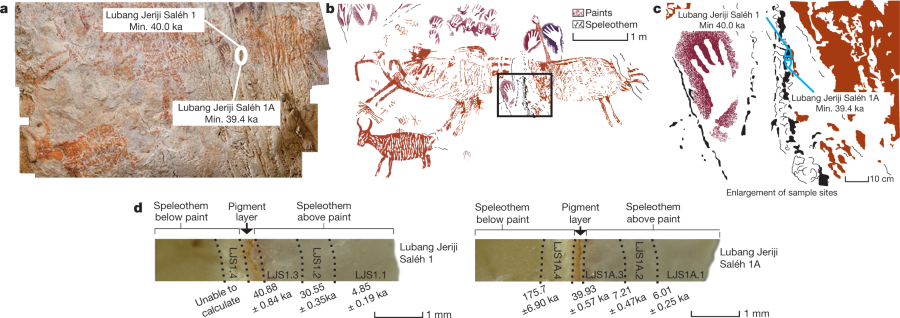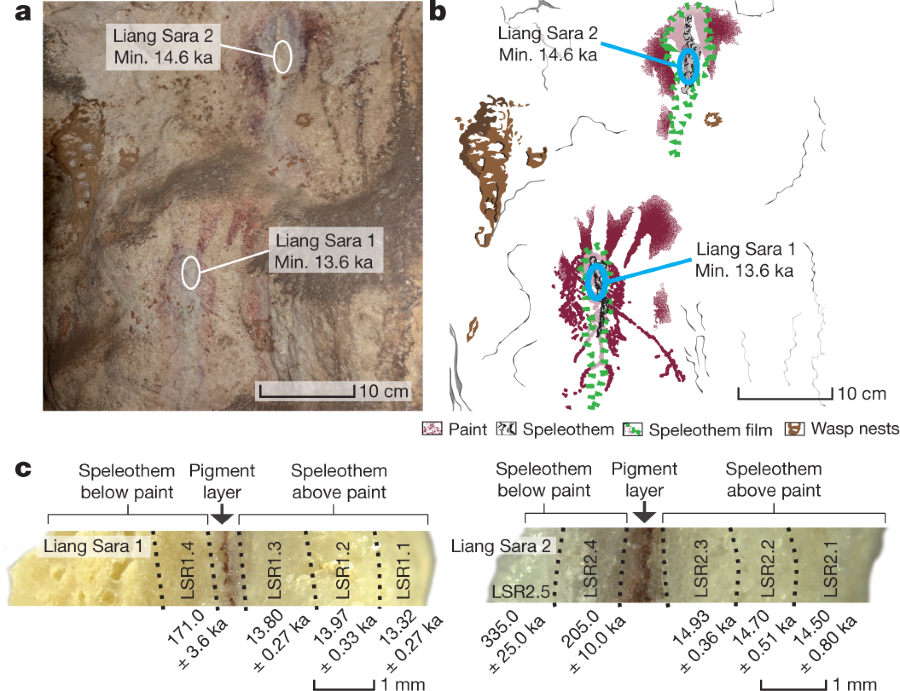Welcome to DU!
The truly grassroots left-of-center political community where regular people, not algorithms, drive the discussions and set the standards.
Join the community:
Create a free account
Support DU (and get rid of ads!):
Become a Star Member
Latest Breaking News
General Discussion
The DU Lounge
All Forums
Issue Forums
Culture Forums
Alliance Forums
Region Forums
Support Forums
Help & Search
Science
Related: About this forumA Bunch of Artists Working with Uranium Based Media Have All Died.
The paper I'll discuss in this post is this one: Palaeolithic cave art in Borneo
(Aubert et al, Nature 564, 254–257 (2018) ).
From the abstract:
Figurative cave paintings from the Indonesian island of Sulawesi date to at least 35,000 years ago (ka) and hand-stencil art from the same region has a minimum date of 40 ka1. Here we show that similar rock art was created during essentially the same time period on the adjacent island of Borneo. Uranium-series analysis of calcium carbonate deposits that overlie a large reddish-orange figurative painting of an animal at Lubang Jeriji Saléh—a limestone cave in East Kalimantan, Indonesian Borneo—yielded a minimum date of 40 ka, which to our knowledge is currently the oldest date for figurative artwork from anywhere in the world. In addition, two reddish-orange-coloured hand stencils from the same site each yielded a minimum uranium-series date of 37.2 ka, and a third hand stencil of the same hue has a maximum date of 51.8 ka. We also obtained uranium-series determinations for cave art motifs from Lubang Jeriji Saléh and three other East Kalimantan karst caves, which enable us to constrain the chronology of a distinct younger phase of Pleistocene rock art production in this region.
Apparently, this is the oldest know art on Earth. Let's cut to the chase and take a look at the art from a figure in the paper:

The caption:
Samples LJS1 and LJS1A are shown. a–c, Photograph (a) and tracing (b, c) showing the locations of the dated speleothems (n?=?2) and associated painting: a large in-filled reddish-orange-coloured naturalistic depiction of an animal shown in profile. Although the animal figure has deteriorated, we interpret it as a figurative representation of what is possibly a wild bovid (Bornean banteng). Panel c is an enlargement of the area marked by a black box in b. d, Profiles of the speleothem showing the micro-excavated subsamples and associated U-series dates. Photograph, L.-H. Fage; tracing, L. Huntley, based on previously published data6 and at www.kalimanthrope.com.
This art was discovered in a remote area featuring very challenging access:
Since the 1990s, thousands of rock art images have been documented in the karst caves of the Sangkulirang–Mangkalihat Peninsula in East Kalimantan, a province in the Indonesian portion of Borneo2,3,4,5,6,7,8,9,10,11 (P.S., unpublished observations) (Fig. 1). This remote and difficult-to-access region contains 4,200 km2 of karst outcrops9,12 that are formed of late Eocene to early Pliocene limestone13. The karst terrain is characterized by densely forested mountain chains and towering cliffs that reach heights of several hundred metres. The Sangkulirang–Mangkalihat Peninsula is adjacent to the edge of the Sunda Shelf—a continental shelf that descends to about 2,500 m in depth—and therefore even during low sea-level stands in the Pleistocene, the karsts were situated essentially at the southeastern tip of Eurasia (Fig. 1).
Don't worry about those "densely forested" mountain chains, by the way. We'll kill the forests soon enough, if not by logging, then by climate driven fire. Once it's cleared you'll be able to drive your Tesla SUV right up to them.
If, by the way, you actually want to review some of this oldest art on Earth, you should click on the link to the paper. The paper itself is behind a fire wall, but I believe the the supplementary Extended Data and Supplemental files are open sourced and you can take a look.
One may also learn about the chemical composition of these pigments in these files. In particular, one can learn the isotopic signature of the uranium, natural thorium, and thorium-230, the decay product of uranium-238. The ratio of the latter two and the distance from the secular equilibrium point: the point at which thorium-230 concentrations in a particular sample are decaying at the same rate as they are being formed. This distance from this equilibrium point gives the age of the sample. The concentrations of uranium are on the order of parts per million, and the thorium-230 on the order of parts per trillion. The lower decay products are probably not useful to look at, since the caves surely have been leaching radon gas since they formed.
Other common dating techniques using natural radionuclides are, of course, carbon-14 (which has moved from its previous equilibrium point owing to nuclear testing in the 20th century) and rubidium/strontium 87 for very old rocks. Certain lanthanides can also be utilized in this way, since many of the natural lanthanides contain significant amounts of radioactive isotopes.
Here, from the full paper's text is a description of these determination:
U–Th dating was carried out using a Nu Plasma multi-collector inductively-coupled plasma mass spectrometer (MC-ICP-MS) in the Radiogenic Isotope Facility at the School of Earth and Environmental Sciences, University of Queensland, following chemical treatment procedures and MC-ICP-MS analytical protocols that have previously been described32,33,34. Powdered sub-samples weighing 3–170 mg were spiked with a mixed 229Th–233U tracer and then completely dissolved in concentrated HNO3. After digestion, each sample was treated with H2O2 to decompose trace amounts of organic matter (if any) and to facilitate complete sample-tracer homogenization. Uranium and thorium were separated using conventional anion-exchange column chemistry, using Bio-Rad AG 1-X8 resin. After stripping off the matrix from the column using double-distilled 7 N HNO3 as eluent, 3 ml of a 2% HNO3 solution mixed with trace amount of HF was used to elute both uranium and thorium into a 3.5-ml pre-cleaned test tube, ready for MC-ICP-MS analyses, without the need for further drying down and re-mixing. After column chemistry, the U–Th mixed solution was injected into the MC-ICP-MS through a DSN-100 desolvation nebulizer system with an uptake rate of around 0.1 ml per minute. The U–Th isotopic ratio measurement was performed on the MC-ICP-MS using a detector configuration to enable simultaneous measurements of both uranium and thorium34,35. The activity ratios of 230Th/238U and 234U/238U of the samples were calculated using the previously published decay constants36. U–Th dates were calculated using the Isoplot Ex 3.75 Program37.
Beautiful analytical chemistry...
The pigments themselves are actually not uranium based by the way, except to the extent that the carbonates therein carried leaching uranium. The pigments, most of which are said to have a "mulberry" color were largely iron based.
The title of this post by the way, represents an abuse of language. This abuse is deliberate.
Uranium is a ubiquitous element, as common as tin. There are between 4.5 and 5 billion tons of it in the oceans alone. I offered significant detail on planetary flows of uranium - giving the references - elsewhere on the internet: Sustaining the Wind, Part 3, Is Uranium Exhaustible?
The very large source of uranium resulting in human exposure is from fertilizer, since uranium has a high affinity for phosphate. (Phosphate ores in Florida were once considered as uranium ores, until richer sources of uranium were found. These same ores are now dug to make fertilizer and the uranium in them is not removed; it would be too expensive to do so.)
The existence of uranium is the last best hope of the human race as the planetary atmosphere collapses owing to the ongoing catastrophe of climate change. Regrettably, fear of this element in the periodic table - it is a chemically toxic element, as is the natural arsenic found in many worldwide water supplies, most notably Bangladesh - prevents its use to save what still might be saved. It is worth noting that over the long term, especially in continuous recycling schemes that nuclear power can reduce the radioactivity of the planet.
Studies of approaches to make uranium available for all future generations have the added benefit of being able to remove uranium from dilute sources. This can serve to remediate any uranium contamination anywhere, where the health risks are unacceptable.
The absurd title here surely is of a type that, without the text to which it refers, might induce some of the types of hysteria one hears from time to time, for example the bathos focus on a few hundred Dine uranium miners in Arizona who worked in the 1950s to the exclusion of the 250 million+ people who died from air pollution since 1960.
The title is absurd here, because our focus is absurd, because we need to think critically.
Have a wonderful weekend.
InfoView thread info, including edit history
TrashPut this thread in your Trash Can (My DU » Trash Can)
BookmarkAdd this thread to your Bookmarks (My DU » Bookmarks)
2 replies, 1695 views
ShareGet links to this post and/or share on social media
AlertAlert this post for a rule violation
PowersThere are no powers you can use on this post
EditCannot edit other people's posts
ReplyReply to this post
EditCannot edit other people's posts
Rec (4)
ReplyReply to this post
2 replies
 = new reply since forum marked as read
Highlight:
NoneDon't highlight anything
5 newestHighlight 5 most recent replies
= new reply since forum marked as read
Highlight:
NoneDon't highlight anything
5 newestHighlight 5 most recent replies
A Bunch of Artists Working with Uranium Based Media Have All Died. (Original Post)
NNadir
Dec 2018
OP
eppur_se_muova
(36,281 posts)1. There's a minor logical flaw in the method ...
We can get an estimate of the last date the paintings were touched-up by ancient curators, not necessarily the date they were created.
![]()
![]()
![]()
NNadir
(33,541 posts)2. Well then, the ancient curators lived 40,000 years ago. One wonders...
...the ancient security people kept ancient visitors from getting too close to the paintings.
The whole time I was reading this paper, I wondered to myself how much damage was done to the paintings by the analysis. It does seem that the authors were very, very careful though.
The free supplementary info has quite a bit of information by the way.
Here's a nice graphic from the paper's body refering to the layering in the sample:

The caption:
Samples LSR1 and LSR2 are shown. a, b, Photograph (a) and tracing (b) showing the locations of the dated speleothems (n?=?2) and associated mulberry-coloured hand stencils and human figure. The small anthropomorph is superimposed over a hand stencil in mulberry-coloured pigment. It appears to be wearing a large headdress and holding a spear. c, Profiles of the speleothem showing the micro-excavated subsamples and associated U-series dates. Tracing, L. Huntley.
The disequilibrium observed actually derives from the "spelothems" which is the carbonate deposits formed over the paintings themselves over the millennia.